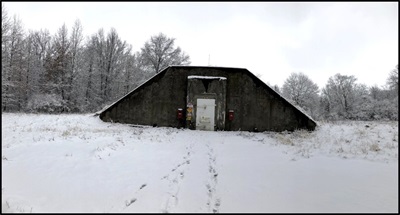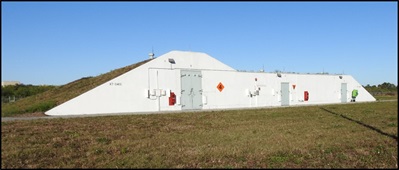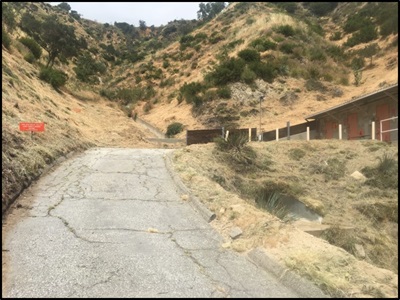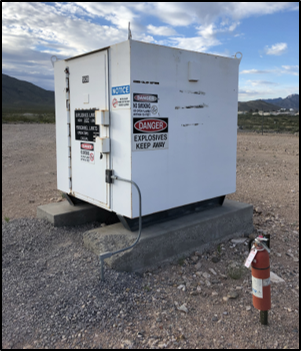Vegetation control is a necessary and effective tool to minimize the risk of fire propagation into explosives storage magazines, which could lead to dangerous and costly accidents. Generally, vegetation around explosives storage sites is strictly controlled. The Department of Energy, U.S. Department of Agriculture, Federal Bureau of Investigation and Transportation Security Administration all have specific regulations to control the potential damage to explosives storage magazines from a nearby fire. Similarly, NASA has NASA-STD-8719.12, Safety Standard for Explosives, Propellants, and Pyrotechnics section 5.4 Vegetation Control, which outlines the basic agency requirements for managing vegetation. However, how each center implements these controls varies to accommodate the centers’ environments and needs.
“It’s essential that centers have a thorough plan for managing vegetation that aligns with the standard, and a key part of that needs to be a maintenance plan,” explained Mike Hallock, White Sands Test Facility’s Explosives Safety Officer (ESO). “If there’s a fire, we need to keep it from reaching the magazines, so the area needs to be clear of flammable materials, like vegetation. It’s also important to keep in mind that local fire departments usually won’t fight explosives fires, therefore we must do everything we can to protect the explosives from unrelated fires.”
Specifically, NASA-STD-8719.12 states
“5.4.1 Vegetation around storage magazines, explosives operating facilities, test stands, and test areas shall be controlled to minimize potential damage to the magazine or facility from grass, brush, forest fires, or erosion.
“5.4.2 A firebreak at least 50 feet wide and free from combustible material should be maintained around storage magazines, explosives operating facilities, test stands, and test areas.

Plum Brook Station: Earth-covered magazine; note the set back of the tree line from the magazine. The aerial above the entrance on top of the magazine is the forward component of the Lightning Protection System (LPS).
“5.4.3 If the aboveground magazine or explosives facility exterior is fire resistant, the firebreak need not be devoid of vegetation, but growth shall be maintained to prevent rapid transmission of fire to the magazine or facility.
“5.4.4 Maintenance of firebreaks and cutting of vegetation around earth-covered magazines are not normally required. Vegetation around ventilators shall be maintained to prevent transmission of a fire into a structure.”
Glenn Research Center, and its satellite facility Plum Brook Station (now Neil A. Armstrong Test Facility), both in Ohio, use Maximo to track a regular mowing maintenance schedule and spot clearing around magazine ventilators to limit the amount of grass and brush. After scheduled maintenance twice a year, John Bobanga, Glenn’s ESO, or a member of his team, inspects and verifies the area.
“The need to limit the probability of combustible vegetation catching on fire and to slow its spread is carefully judged against operational factors, cost to control and erosion prevention,” said Bobanga. “As far as frequency, we concluded that going more often [than planned] is not necessary and it would increase the chance of creating ridges and possibly eroding the soil.”
Bobanga notes this as an important aspect of vegetation control: While keeping vegetation cut low is important, it is also a delicate balance, as excessive mowing or use of soil sterilant can lead to soil erosion, significantly affecting the protection provided and therefore storage capabilities.

Kennedy: Long-term storage multi-cubicle earth-covered magazine at the joint NASA/Cape Canaveral Air Force Station PES. Note, the vegetation is well maintained along the front, side and top of the magazines. Off to the left side, a portion of the PES security fence can bee seen in the distance. The tree line is set back from the fence. Note the aerial components of the magazine’s LPS.
Kennedy Space Center also uses Maximo to manage the center’s basic mowing maintenance schedule. In general, Kennedy mows the ordnance storage area every other month, and its propellant fuel storage areas more frequently. However, the variable environment sometimes requires modifications to the plans.
“It’s Florida, sometimes we are in rainy season and sometimes we’re in drier seasons where it’s not growing as quick,” said Bob Russo, Kennedy’s ESO. “If it grows out of cycle, we call our maintenance team and they will mow.”;
While the center also uses sprays to limit growth on the fence line, Kennedy tries to limit the use of such products.
“We’re in an animal refuge area, so we have to be leery for our animals we’re sharing the area with,” said Russo.
While the Jet Propulsion Laboratory (JPL) uses what David Larriva, JPL’s ESO, calls “the old-fashioned way” of managing growth — i.e., mowing — it also has a unique environment to contend with between the dry environment causing increased risk of brush fires and the lab’s location at the base of a foothill.

JPL: Long-term storage multi-cubicle above-ground magazine is located at the base of a ravine. Note, the vegetation is well maintained above ravine. In the background there's a concrete trough to guide rain runoff down hill.
“Our location is tucked into a little valley between mountains, so we have to be mindful that we don’t cut the grass too low or cut too much vegetation, as the vegetation helps hold the mud and soil to the mountain slope,” explained David Larriva, JPL’s ESO. “If we get rain with too little vegetation, we get mud slides. We have a unique environment.”
“We live in in California with brush fires being an issue,” added Larriva. “Managing vegetation and cutting down brush around magazines corresponds with our regular maintenance plans for fire breaks around the center. What we ask above and beyond that is for a closer interval of a quarterly check of our grass because we want to make sure the growth is low.”

White Sands: Long-term above-ground magazine. Note, the vegetation is well maintained around the magazine.
White Sands is located in a desert, at the base of a granite mountain, surrounded primarily with rocky terrain, so it does not see excessive growth it needs to manage. The facility, like others, manages its vegetation maintenance program schedule in Maximo. It also sprays for weeds at all magazine locations. Gunite is used to manage erosion at the Potential Explosives Sites, or PES (long-term explosives storage). Hallock explains that while gunite prevents weeds from reaching the magazines for 10-15 years, over time, it cracks and weeds can grow through, hence the need to also spray the area.
“A lot of it has to do with our terrain,” said Hallock. “We’re very fortunate that we’re a relatively arid environment. We don’t have a lot of vegetation, but we watch our April-May growing season and August-September monsoon season.”
Which is in line with Hallock’s advice to all centers with regards to managing vegetation: Understand the center’s growth patterns and plan and act accordingly.
Questions about vegetation policy can be directed to Hallock or Sandy Hudson, Explosives and Pyrotechnics Safety program executive.